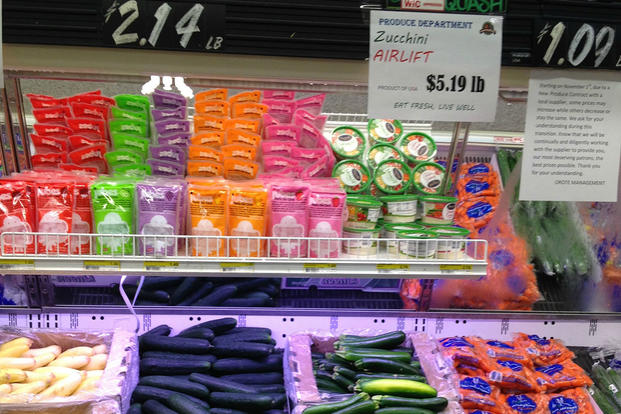Prices for fresh produce at commissaries in Guam have skyrocketed since Nov. 1 when a new contract started requiring the supplier rather than the Defense Department to pay for shipping goods, according to military families stationed there.
"I have been astonished at the prices here in Guam," Kelsey Pauxtis-Thomas, a pregnant Navy wife who was moved to Guam with her husband early this fall, told Military.com. "I expected high but not like this.
"In the short time we've been here, we've seen organic lettuce go from $3.99 to almost $11. Fresh berries are at a premium skyrocketing as high as $9. Here in Guam, most everything is frozen and thawed upon arrival including dairy, milk and bread. Fresh vegetables and fruit are becoming a luxury item instead of a staple," she said. "At seven months pregnant, I shouldn't be stressed about my grocery budget."
Shoppers at the Orote commissary on Guam Naval Base said that among the high produce prices this month was $7.47 per pound for some bell pepper varieties and up to $10.69 a bag for packaged, pre-washed lettuce.
Under the previous fresh fruits and vegetables contract, the Defense Commissary Agency paid about $48 million a year for sending fruit and vegetables by airlift or cargo ship to commissaries in Japan, Korea and Guam. The new contract, however, eliminates that taxpayer subsidy and instead requires the contractor to pay shipping. That cost is then passed on to the commissary and ultimately the shoppers in the price of the products.
A sign in the Orote commissary warns shoppers that prices might increase as a result of the change.
"Starting November 1, due to a new produce contract with a local supplier, some prices may increase while others decrease or stay the same," the sign reads. "We ask for your understanding during this transition."
Shoppers told Military.com that the majority of produce increased in price, though some products did decrease, such as unwashed bundles of Romaine lettuce, which fell from $3 each to under $2 each.
Military families in Guam do receive a cost of living adjustment (COLA) payment, the amount of which is dependent on paygrade, time in service and number of dependents. An E-3 in Guam with two dependents receives about $22 a day, while an O-3 with two dependents receives about $30.
But military family members said the survey deciding the COLA rates for 2016, which have yet to be released, was conducted before the new price increases. That means the new yearly rate won't reflect the higher cost of living -- leaving less money in military families' pockets, they said.
"My husband is deployed and I looked at the cost of purchasing tickets to fly home for Christmas before the increase in prices at the commissary and we could not afford it. We definitely won't be able to afford it now," Mary Moses, a Navy spouse, wrote in a letter sent this week the House Armed Services committee chairman, Rep. Mac Thornberry, a Republican from Texas.
The higher costs do not come as a total surprise. As part of the House version of the 2016 National Defense Authorization Act, lawmakers blocked the commissary system from putting in place the new contract. The provision, however, was not included in the final version of the bill which the president signed late last month.
The commissary annually receives about $1.4 billion in taxpayer funding. However, as part of the 2016 NDAA, defense officials have been instructed to develop a plan for the agency to fund its own operating costs.
Commissary officials said while prices have fluctuated in Korea and Japan -- the two other countries served by the new contract -- Guam has experienced the most dramatic change. They said they're working with the new contractor to find more local produce sources so that produce shipped into the country does not have to be transported as far and to ship more produce by boat rather than by airlift.
"It is difficult to determine what the long-term change in price will look like because of the volatility of fresh fruits and vegetables, however, we believe that the current fluctuations being seen will be minimized early next year," said Kevin Robinson, a commissary spokesman.
--Amy Bushatz can be reached at amy.bushatz@military.com. Follow her on Twitter @amybushatz.




























